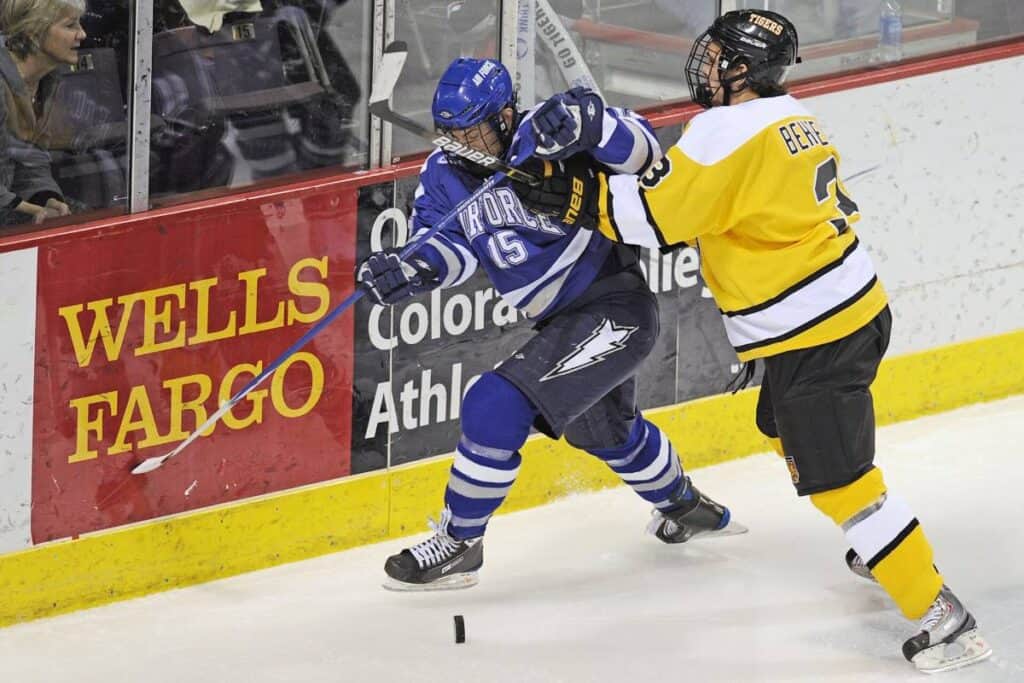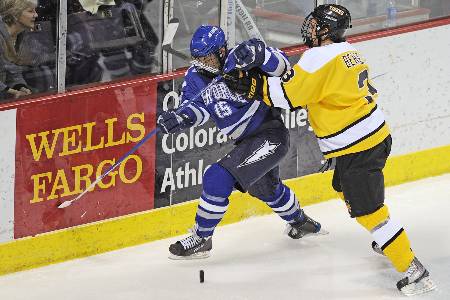
If you watch enough hockey, you’ll hear play-by-play announcers reference “PIMs” when referring to a current player or an up-and-coming prospect.
But what are PIMs?
PIM is a statistical category in hockey and stands for penalty infraction minutes. It is commonly tracked for individual players and teams. PIMs, more commonly referred to as penalty minutes are given out by the referee when a player violates the rules of the game and are expressed as the summation of penalty minutes amassed by a player or team over some time.
Typically, penalties result in the offending player spending time in the penalty box and unable to participate in play, while his/her team plays “short-handed” or with one less player on the ice for a period of time, depending on the severity of the infraction.
This time is known as the penalty kill for the short-handed team, or a power play for the opposing team. A power play is a huge advantage in hockey because when a team has more skaters than the opponent, it means that someone on the ice is always open creating more scoring chances. Additionally, with a player in the penalty box, there is more open ice, creating additional time for players to make decisions and more accurate passes.
Most teams have special personnel combinations for when their team is on the power play as teams will often put a combination of their most skilled passers and shooters on the power play in hopes of creating as many scoring chances as possible. History shows that power plays have proven to be effective for the team with the man-advantage as about 20% of a team’s goals throughout a season are scored on the power play (http://www.nhl.com/stats/teams).
A penalty at the wrong time can completely change the momentum and outcome of a game, so let’s explore the different types of penalties that one can expect to see during a hockey game.
How Long Are Penalties in Hockey?
Penalties come in various severities including a minor, double minor, major, misconduct, game misconduct, and match, with each coming with different punishments for the offending player and his/her team.
Penalties are given out for a wide array of offenses. Here is a table that summarizes the types of penalties and the related disciplinary action:
| Type of Penalty | Disciplinary Action |
| Minor Penalty | 2 Minutes |
| Double Minor Penalty | 4 Minutes |
| Major Penalty | 5 Minutes |
| Misconduct Penalty | 10 Minutes |
| Game Misconduct Penalty | Ejected |
| Match Penalty | Ejected + 1 Game Suspension |
What Is a Minor Penalty?
Minor penalties are the least severe infractions and result in two minutes in the penalty box and a power play for the opposing team. They account for about 88% of all penalties called in the NHL. Common types of minor penalties include hooking, slashing, high-sticking, tripping, and interference.
The offender must remain in the box for either the full two minutes or until the opposing team scores a power-play goal – whichever is shorter.
While two minutes may not seem like much of a punishment for breaking the rules, teams on average score one goal for every five power plays that they get, and the best teams in the league score 1 goal for every three power plays they get.
Throughout a season, PIMs can be a big factor in a team’s success, especially considering that the average NHL game has 10 penalties called.
In some cases, players on opposing teams may be given minor penalties at the same time, these are known as coincidental minors. When this happens neither team will be given a power play, the teams will play 4-on-4, and the offending players will remain in the box for the full 2 minutes.
What Is a Double Minor Penalty?
A double-minor penalty can be given out at the referee’s discretion to a player if the infraction is deemed more severe. Per NHL rules, if a high-sticking penalty is called and blood is drawn, a double minor penalty is automatically imposed.
Double minor penalties are treated as two separate penalties, meaning if a goal is scored during the first two minutes of the penalty, the remaining time of the first penalty is dismissed and the second penalty begins to countdown at the ensuing face-off. If no goals are scored, the offending player spends a total of four minutes in the penalty box.
What Is a Major Penalty?

Major penalties are imposed upon players for more severe infractions and are often called in especially dangerous situations. Major penalties result in five penalty minutes to the offending player, and as such, a five-minute power play for the opposing team.
Major penalties are unique in that the offending player must remain in the penalty box, and the offending player’s team remains short-handed for the entirety of the five minutes, regardless of how many goals are scored during the penalty time.
A little-known fact on major penalties is that it is statistically impossible for a team to have a 100% success rate. This is because each goal scored on a major power play counts as 1/1, however, when the time expires on the major penalty it is statistically counted as 0/1 regardless of how many goals were scored.
In other words, if a team scored three goals on a major power play it would be statistically counted as 3/4 or 75%. Major penalties are also automatically imposed on players for fighting. Hockey is the only major sport in which players are not automatically ejected for fighting.
What Is a Misconduct Penalty?
Misconduct penalties are typically given out in conjunction with minor penalties and can be called for a number of reason, however, they are typically related to some sort of unsportsmanlike act, such as yelling at a referee, or causing trouble after a whistle.
When a misconduct penalty is given out, the offending player cannot participate in play for 10 minutes. If the misconduct penalty is called in conjunction with a minor or major penalty then another player on the offending team is designated to serve the minor or major penalty, however, all related PIMs are attributed to the offending player and the team is only short-handed for the related minor or major penalty.
Because the team is not short-handed for the entire time of the misconduct, the offending player is not permitted to return to the ice or bench until the first whistle after the 10 minutes have expired. In a situation where a major penalty is called, teams with the misconduct are not required to have a player serve the major penalty as long as someone is in the penalty box when the penalty ends.
Typically, if there are less than 10 minutes left in the period or the end of the game, the offending player will serve the remainder of the period in the dressing room rather than the penalty box.
What Is a Game Misconduct Penalty?
A game misconduct penalty is very similar to a misconduct penalty however the player is ejected for the remainder of the game regardless of how much time is left and when the infraction occurred. Game misconduct penalties almost always come with a related minor or major penalty due to the severity of infraction that calls for a player to be ejected from the game.
While a player is ejected for the remainder of the game for a game misconduct, the player will receive 10 PIMs in addition to any minor or major penalties assessed with the infraction.
What Is a Match Penalty?
Match penalties are given out for intent to injure an opposing player and almost always come with additional disciplinary measures from the league. When a player receives a match penalty they are ejected from the current game and receive an automatic one-game suspension.
Match penalties always are assessed with an additional major penalty and the rules for having another player in the box are the same as misconduct and game misconduct penalties.
When a match penalty is assessed in the NHL, video review is used to confirm that a match penalty is warranted or the penalty should be reduced. Similar to a game misconduct, regardless of how much time is left in the game when a player receives a match penalty, the player is given 10 PIMs for statistical purposes.
What Is a Penalty Shot?

Penalty shots in hockey are some of the most exciting moments in sports and some of the rarest (less than 50 in most NHL seasons). A penalty shot is a one on one breakaway between skater and goalie.
Penalty shots are given when a clear scoring chance is taken away due to an infraction, which oftentimes is tripping or hooking during a breakaway. However, penalty shots are also given out when a player other than the goalie intentionally covers the puck in the crease, or a player throws their stick to attempt to break up a play.
A little-known fact about penalty shots is that when one is called by the referee, while the offending team’s goalie is pulled, a goal is automatically awarded. Generally speaking, penalty shots result in goals about 33% of the time.
Admittedly, penalty shots have lost some luster over the years, since the shootout was implemented. Shootouts are essentially a series of penalty shots for each team.
FAQ
Who Serves a Goalie Penalty?
Goalies are famous for being “hotheads”, however, they rarely serve their penalties. When a goalie is assessed a minor, major, or misconduct penalty, they are served by another member of the team who was on the ice when the infraction occurred. If a goalie is given a game misconduct or match penalty, then he is ejected and the team’s backup goalie will enter the game.
Are Penalty Minutes Good in Hockey?
Unless you are a fan of the Philadelphia Flyers who earned the nickname “Broad Street Bullies” in the 1970s, penalty minutes are not good in hockey. As the game’s speed and skill level have increased greatly, giving teams a man advantage can prove very costly. About 20% of a team’s goals throughout the season are scored on the power-play.
Who Is the NHL All-Time Leader in PIMs?
The top 3 all-time NHL penalty minute leaders are Dave “Tiger” Williams (3,971), Dale Hunter (3,565), and Tie Domi (3,515). Most of the players near the top of this stat category played in an era of the NHL where fighting was much more commonplace which gave these fearsome players ample opportunity to pad their PIM stats.
Who Is the NHL Single-Season Leader in PIMs?
Dave Schultz, perhaps the most feared player from the Philadelphia Flyers Broad Street Bullies era team, racked up 472 PIMs in 76 games during the 1974-75 season. Despite Schultz’s best efforts, he was not a part of the most penalized team of all time. That record belongs to the 1991-92 Buffalo Sabres who totaled 2,713 PIMs.
